Sedimentary Provenance Analysis of Tight Sandstone Gas Reservoirs in the Middle Jurassic Shaximiao Formation, Western Sichuan Depression
Abstract
1. Introduction
2. Geological Setting

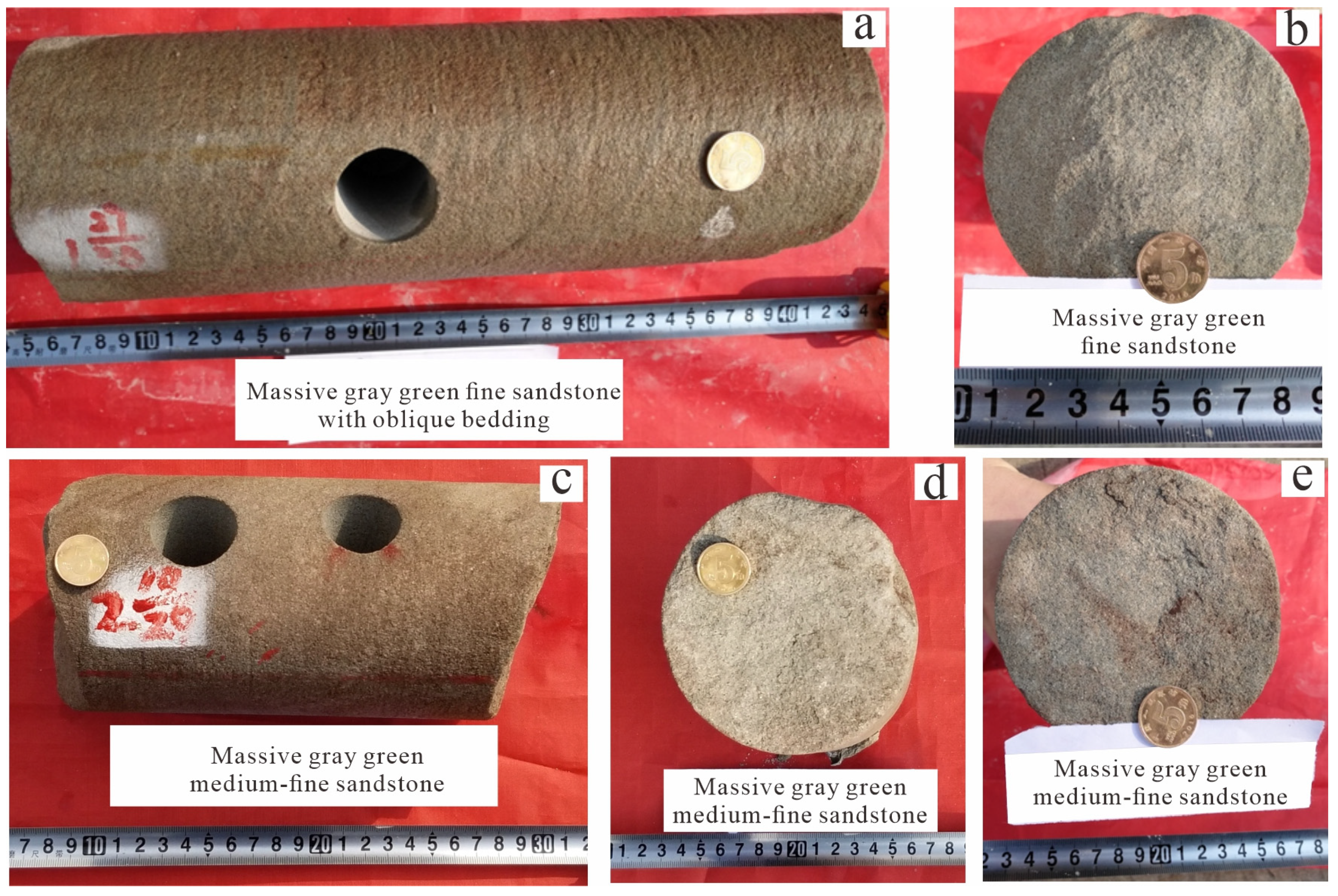
3. Methods
3.1. Experimental Samples
3.2. Heavy Mineral Index Method
3.3. Chemical Variation Index Method
4. Results
4.1. Petrographic Analysis
4.2. Relative Content of Heavy Minerals and Geochemical Elements
5. Discussion
5.1. Analysis of Lithic Fragments
5.1.1. Distribution of Lithic Fragments
5.1.2. Radar Chart Analysis
5.1.3. Ternary Chart Analysis
5.2. Analysis of Heavy Minerals
5.3. Analysis of Geochemical Elements
5.3.1. Analysis of Rare-Earth Element Ratio
5.3.2. Standardized Curve Analysis
5.3.3. Analysis of CIA
5.4. Sedimentary Provenance
6. Conclusions
- (1)
- The tight sandstone of the Shaximiao Formation in the Western Sichuan Depression is mainly composed of quartz, with comparable feldspar and lithic fragment contents. There are significant differences in the structural background characteristics and radar distribution characteristics of lithic fragment materials between the Z region and the X and Q regions, with the J region falling between these two characteristics. The stable and ultra-stable heavy minerals mainly include garnet, zircon, rutile, and tourmaline. The distribution characteristics of heavy minerals in the X, Q, and J regions are relatively similar but differ significantly from those in the Z region. The heavy mineral index characteristics of the Z region indicate that it was far away from the provenance area during the sedimentation period of the Shaximiao Formation.
- (2)
- The distribution characteristics of rare-earth elements vary greatly, while the distribution characteristics of trace elements are similar. The relative difference in Ba element content is 0.84. The geochemical element characteristics of the tight sandstone in the Shaximiao Formation of the X and Q regions are similar, and they may have the same provenance area. The geochemical element characteristics of the Z region are different from those of the X and Q regions, and the provenance area is far away. The geochemical element characteristics of the J region are similar to those of the Z region, and the provenance area is relatively close.
- (3)
- Our multi-method provenance characteristic analysis of tight sandstone in the Shaximiao Formation of the Western Sichuan Depression shows that the provenance characteristics of the X and Q regions are similar, mainly coming from Longmen Mountain. The J region has dual provenances, mainly from Longmen Mountain in the west and Micang–Dabashan in the northeast, with the northeast being relatively far from the provenance area. The material provenance in Zone Z comes from Micang–Dabashan in the northeast, with a straight-line distance of about 300 km from the material provenance area. The long-axis provenance reservoir of the MDTB (northeast) may be of higher quality.
Author Contributions
Funding
Data Availability Statement
Acknowledgments
Conflicts of Interest
Abbreviations
| CIA | Chemical Index of Alteration |
| LMTB | Longmenshan Thrust Belt |
| MDTB | Micang–Dabashan Tectonic Belt |
| ZTR | Zircon–tourmaline–rutile |
| XRD | X-ray diffraction |
| Qm | Monocrystalline quartz |
| Qp | Polycrystalline quartz |
| Lv | Volcanic lithic fragments |
| Lsa | Sedimentary lithic fragments |
| Lm | Metamorphic lithic fragments |
| L (Lv + Lsa + Lm) | Unstable lithic fragments |
| QFL | Quartz, feldspar, and lithic fragments |
| Lt (Lv + Lsa + Lm+ Qp) | Polycrystalline lithic fragments |
References
- Zeng, M.; Zhang, X.; Cao, H.; Ettensohn, F.R.; Cheng, W.; Lang, X. Late Triassic initial subduction of the Bangong-Nujiang Ocean beneath Qiangtang revealed: Stratigraphic and geochronological evidence from Gaize, Tibet. Basin Res. 2016, 28, 147–157. [Google Scholar] [CrossRef]
- Ma, A.; Hu, X.; Garzanti, E.; Han, Z.; Lai, W. Sedimentary and tectonic evolution of the southern Qiangtang basin: Implications for the Lhasa-Qiangtang collision timing. J. Geophys. Res. Solid Earth 2017, 122, 4790–4813. [Google Scholar] [CrossRef]
- Hu, X.; Zhang, Y.; Li, C.; Li, G.; Liu, J.; Li, Y.; Su, J.; Jia, M. Provenance of Wushan Loess in the Yangtze Three Gorges Region: Insights from Detrital Zircon U-Pb Geochronology and Late Pleistocene East Asian Monsoon Variations. Minerals 2025, 15, 1180. [Google Scholar] [CrossRef]
- Tang, M.; Ji, W.-Q.; Chu, X.; Wu, A.; Chen, C. Reconstructing crustal thickness evolution from europium anomalies in detrital zircons. Geology 2020, 49, 76–80. [Google Scholar] [CrossRef]
- Liu, Z.; Chen, P.; Chen, H.; Yu, B.; Mi, R.; Qiu, L.; Fu, Y.; Zeng, Q. Sedimentary Processes of the Dazhuyuan Formation in Northern Guizhou (Southwest China): Evidence from Detrital Zircon Geochronology and Whole Rock Geochemistry. Minerals 2025, 15, 1167. [Google Scholar] [CrossRef]
- Wang, Z.; Zhan, W.; Wang, J.; Peng, Q.; Wei, W.; Wang, D.; Ma, Q.; Song, C.; Feng, X. Geochemistry and zircon geochronology of the Late Triassic volcanic–sedimentary successions in northern Tibet: Implications for the provenance and tectonic evolution of the Mesozoic Qiangtang Basin. Gondwana Res. 2023, 117, 321–343. [Google Scholar] [CrossRef]
- Qu, X.; Wang, Q.; Wang, D.; Lei, T.; Chen, H.; Wang, J.; Jiang, W.; Zhang, W.; Luo, L.; Liu, J.; et al. Provenance of Volcanogenic Deposits from the Shanxi Formation of the Daniudi Gas Field, Ordos Basin, and Its Tectonic Implications. Minerals 2023, 13, 1546. [Google Scholar] [CrossRef]
- Gao, S.; Xu, Z.; Xie, C.; Ma, Z.; Deng, P.; Liu, H. Late Triassic sedimentary environments and detrital zircon provenance analysis in the Amdo area of the Tibetan Plateau: Implications for the evolution of the Meso-Tethys Ocean. Palaeogeogr. Palaeoclim. Palaeoecol. 2025, 657, 112601. [Google Scholar] [CrossRef]
- Bhatia, M.R.; Crook, K.A.W. Trace element characteristics of graywackes and tectonic setting discrimination of sedimentary basins. Contrib. Miner. Pet. 1986, 92, 181–193. [Google Scholar] [CrossRef]
- Hu, L.S.; Du, Y.S.; Cawood, P.A.; Xu, Y.J.; Yu, W.C.; Zhu, Y.H.; Yang, J.H. Drivers for late Paleozoic to early Mesozoic orogenesis in South China: Constraints from the sedimentary record. Tectonophysics 2014, 618, 107–120. [Google Scholar] [CrossRef]
- Fan, J.-J.; Li, C.; Wang, M.; Xie, C.-M.; Xu, W. Features, provenance, and tectonic significance of Carboniferous–Permian glacial marine diamictites in the Southern Qiangtang–Baoshan block, Tibetan Plateau. Gondwana Res. 2015, 28, 1530–1542. [Google Scholar] [CrossRef]
- Abudeif, A.M.; Aal, G.Z.A.; Abdelbaky, N.F.; Ali, M.H.; Mohammed, M.A. An Integrated Geophysics and Isotope Geochemistry to Unveil the Groundwater Paleochannel in Abydos Historical Site, Egypt. Minerals 2023, 13, 64. [Google Scholar] [CrossRef]
- Berzina, A.N.; Berzina, A.P.; Gimon, V.O. Paleozoic–Mesozoic Porphyry Cu(Mo) and Mo(Cu) Deposits within the Southern Margin of the Siberian Craton: Geochemistry, Geochronology, and Petrogenesis (a Review). Minerals 2016, 6, 125. [Google Scholar] [CrossRef]
- Liu, S.; Liu, Y. Sedimentary Characteristics Analysis and Sedimentary Facies Prediction of Jurassic Strata in the Northwest Margin of Junggar Basin—Covering the W105 Well Region in the Wuerhe Area. Minerals 2022, 12, 68. [Google Scholar] [CrossRef]
- Hu, P.-Y.; Zhai, Q.-G.; Cawood, P.A.; Weinberg, R.F.; Zhao, G.-C.; Zhou, R.-J.; Tang, Y.; Liu, Y.-M. Detrital zircon REE and tectonic settings. Lithos 2024, 480–481, 107661. [Google Scholar] [CrossRef]
- Stalder, R.; Jaeger, D.; Andò, S.; Garzanti, E.; Chiessi, C.; Sawakuchi, A.; Ludwig, T.; Strasser, M. Trace element and OH content of quartz grains in the Amazon river: Potential application in provenance analysis. Sediment. Geol. 2025, 480, 106853. [Google Scholar] [CrossRef]
- Yao, X.; Feng, C.; Zhou, W.; Wu, P.; Qu, H.; Lei, J.; Chen, Z.; Ge, Y.; Sun, M. The sedimentary provenance of Upper Miocene Dongfang submarine fan, Yinggehai Basin: Source-to-sink system unravelled through new detrital zircon U-Pb ages and heavy mineral analysis. Mar. Pet. Geol. 2025, 182, 107557. [Google Scholar] [CrossRef]
- Ocheli, A.; Ogbe, O.B.; Omoko, E.N.; Aigbadon, G.O. Stratigraphic correlation and provenance study of exposed Eocene—Oligocene sedimentary sequences in southern Nigeria using high-resolution heavy minerals and garnet geochemical analyses. Solid Earth Sci. 2024, 9, 100189. [Google Scholar] [CrossRef]
- Jagodziński, R.; Sternal, B.; Stattegger, K.; Szczuciński, W. Sediment distribution and provenance on the continental shelf off the Mekong River, SE Vietnam: Insights from heavy mineral analysis. J. Asian Earth Sci. 2020, 196, 104357. [Google Scholar] [CrossRef]
- O’Sullivan, G.; Chew, D.; Kenny, G.; Henrichs, I.; Mulligan, D. The trace element composition of apatite and its application to detrital provenance studies. Earth-Science Rev. 2020, 201, 103044. [Google Scholar] [CrossRef]
- Etimita, O.M.; Beka, F.T. Heavy mineral analysis of Eocene sands and sandstones of Nanka Formation, Cenozoic Niger Delta petroleum province. Geol. Ecol. Landsc. 2020, 4, 251–256. [Google Scholar] [CrossRef]
- Bauer, S.; Yang, J.; Stuckman, M.; Verba, C. Rare Earth Element (REE) and Critical Mineral Fractions of Central Appalachian Coal-Related Strata Determined by 7-Step Sequential Extraction. Minerals 2022, 12, 1350. [Google Scholar] [CrossRef]
- Chen, G.; Robertson, A.H. User’s guide to the interpretation of sandstones using whole-rock chemical data, exemplified by sandstones from Triassic to Miocene passive and active margin settings from the Southern Neotethys in Cyprus. Sediment. Geol. 2020, 400, 105616. [Google Scholar] [CrossRef]
- Bao, Y.; Sun, M.; Wang, Y.; Lu, J.; Wu, Y.; Chen, H.; Li, S.; Qin, Y.; Wang, Z.; Wen, J.; et al. Impact of cascade reservoir on the sources of organic matter in sediments of Lancang river. iScience 2025, 28, 111681. [Google Scholar] [CrossRef]
- Bello, A.M.; Usman, M.B.; Amao, A.O.; Salisu, A.M.; Al-Ramadan, K.; Abubakar, U.; Mukkafa, S.; Kwami, I.A.; Chiroma, L.U.; Al-Hashem, M.; et al. Linking provenance and diagenesis to reservoir quality evolution of sandstones: The Paleocene-Eocene Kerri-Kerri Formation, northeastern Nigeria. Mar. Pet. Geol. 2025, 172, 107227. [Google Scholar] [CrossRef]
- Chen, X.; Ji, Y.; Yang, K. Impacts of sedimentary characteristics and diagenesis on reservoir quality of the 4th member of the Upper Triassic Xujiahe formation in the western Sichuan basin, southwest China. Mar. Pet. Geol. 2024, 167, 106981. [Google Scholar] [CrossRef]
- Feng, S.; Xie, R.; Radwan, A.E.; Wang, Y.; Zhou, W.; Cai, W. Accurate determination of water saturation in tight sandstone gas reservoirs based on optimized Gaussian process regression. Mar. Pet. Geol. 2023, 150, 106149. [Google Scholar] [CrossRef]
- Yue, D.; Wu, S.; Xu, Z.; Xiong, L.; Chen, D.; Ji, Y.; Zhou, Y. Reservoir quality, natural fractures, and gas productivity of upper Triassic Xujiahe tight gas sandstones in western Sichuan Basin, China. Mar. Pet. Geol. 2018, 89, 370–386. [Google Scholar] [CrossRef]
- Liu, S.; Yang, Y.; Deng, B.; Zhong, Y.; Wen, L.; Sun, W.; Li, Z.; Jansa, L.; Li, J.; Song, J.; et al. Tectonic evolution of the Sichuan Basin, Southwest China. Earth-Sci. Rev. 2021, 213, 103470. [Google Scholar] [CrossRef]
- Feng, S.; Xiong, L.; Radwan, A.E.; Xie, R.; Yin, S.; Zhou, W. Accurate identification of low-resistivity gas layer in tight sandstone gas reservoirs based on optimizable neural networks. Geoenergy Sci. Eng. 2024, 241, 213094. [Google Scholar] [CrossRef]
- Feng, S.; Xie, R.; Zhou, W.; Yin, S.; Chen, J.; Zhang, M.; Luo, Z. The new interpretation of the geological origin about differentiation phenomenon of resistivity in the tight sandstone reservoir. Arab. J. Geosci. 2021, 14, 2074–2089. [Google Scholar] [CrossRef]
- Feng, S.; Xie, R.; Zhou, W.; Yin, S.; Deng, M.; Chen, J.; Zhang, Z.; Xiang, M.; Luo, Z. A new method for logging identification of fluid properties in tight sandstone gas reservoirs based on gray correlation weight analysis—A case study of the Middle Jurassic Shaximiao Formation on the eastern slope of the Western Sichuan Depression, China. Interpretation 2021, 9, T1167–T1181. [Google Scholar] [CrossRef]
- Nesbitt, H.W.; Young, G.M. Early Proterozoic climates and plate motions inferred from major element chemistry of lutites. Nature 1982, 299, 715–717. [Google Scholar] [CrossRef]
- Bhatia, M.R. Plate tectonics and geochemical composition of sandstones. J. Geol. 1983, 91, 611–627. [Google Scholar] [CrossRef]
- Dickinson, W.R. Interpreting Provenance Relations from Detrital Modes of Sandstones. In Provenance of Arenites; Zuffa, G.C., Ed.; D. Reidel Publishing Company: Dordrecht, The Netherlands, 1985; Volume 148, pp. 333–362. [Google Scholar] [CrossRef]
- Pourmand, A.; Dauphas, N.; Ireland, T.J. A novel extraction chromatography and MC-ICP-MS technique for rapid analysis of REE, Sc and Y: Revising CI-chondrite and Post-Archean Australian Shale (PAAS) abundances. Chem. Geol. 2012, 291, 38–54. [Google Scholar] [CrossRef]
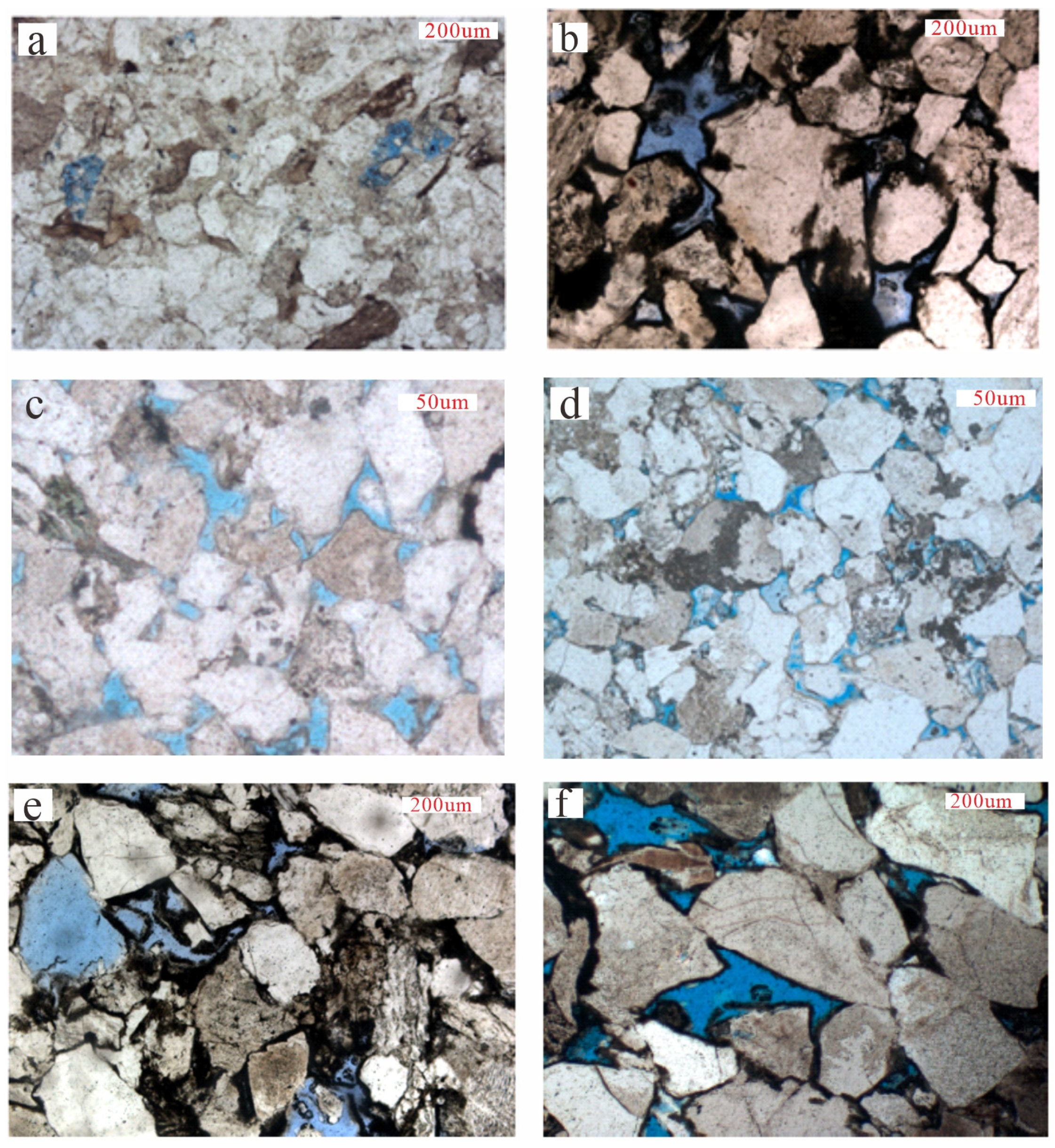
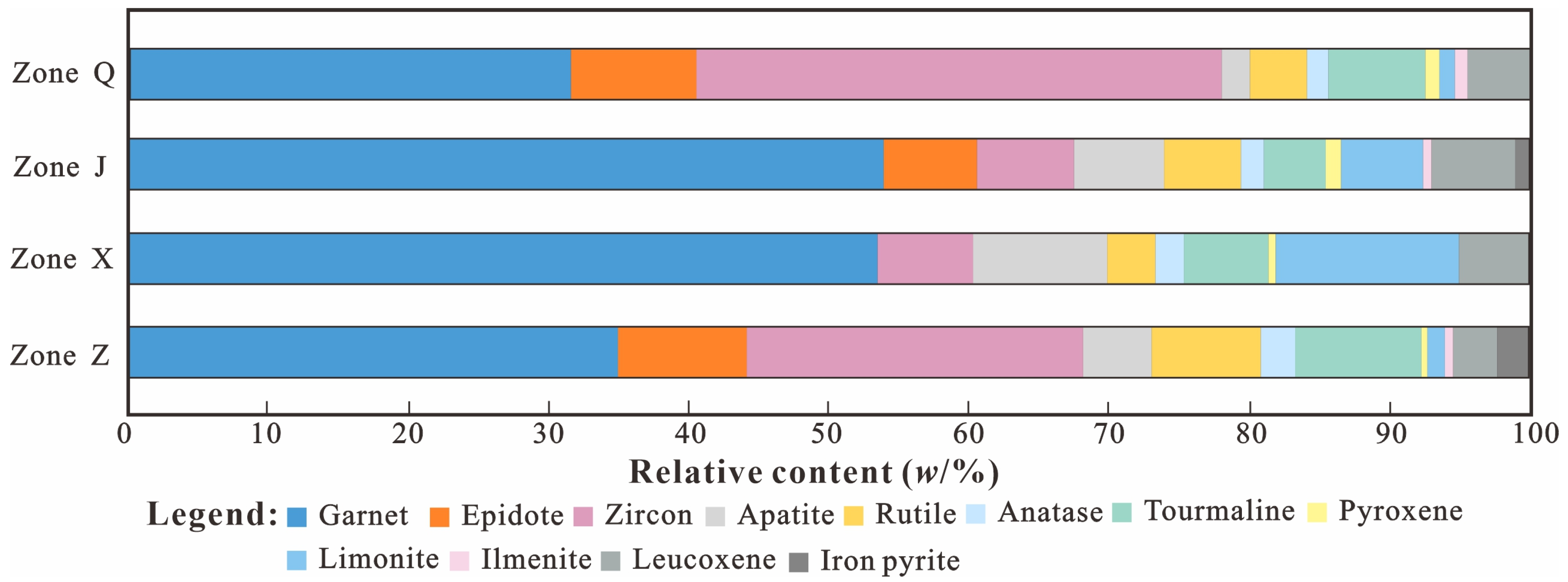


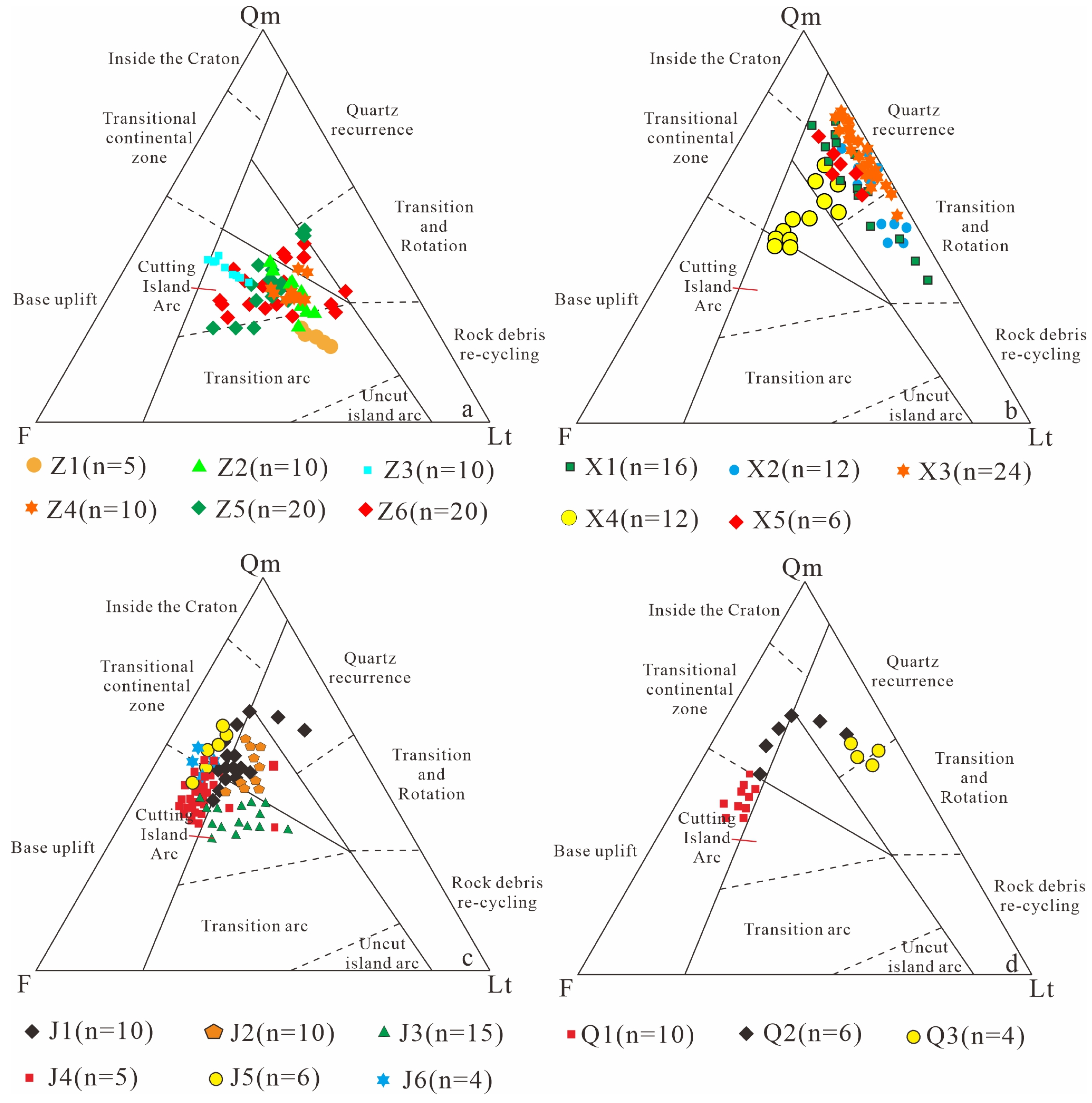
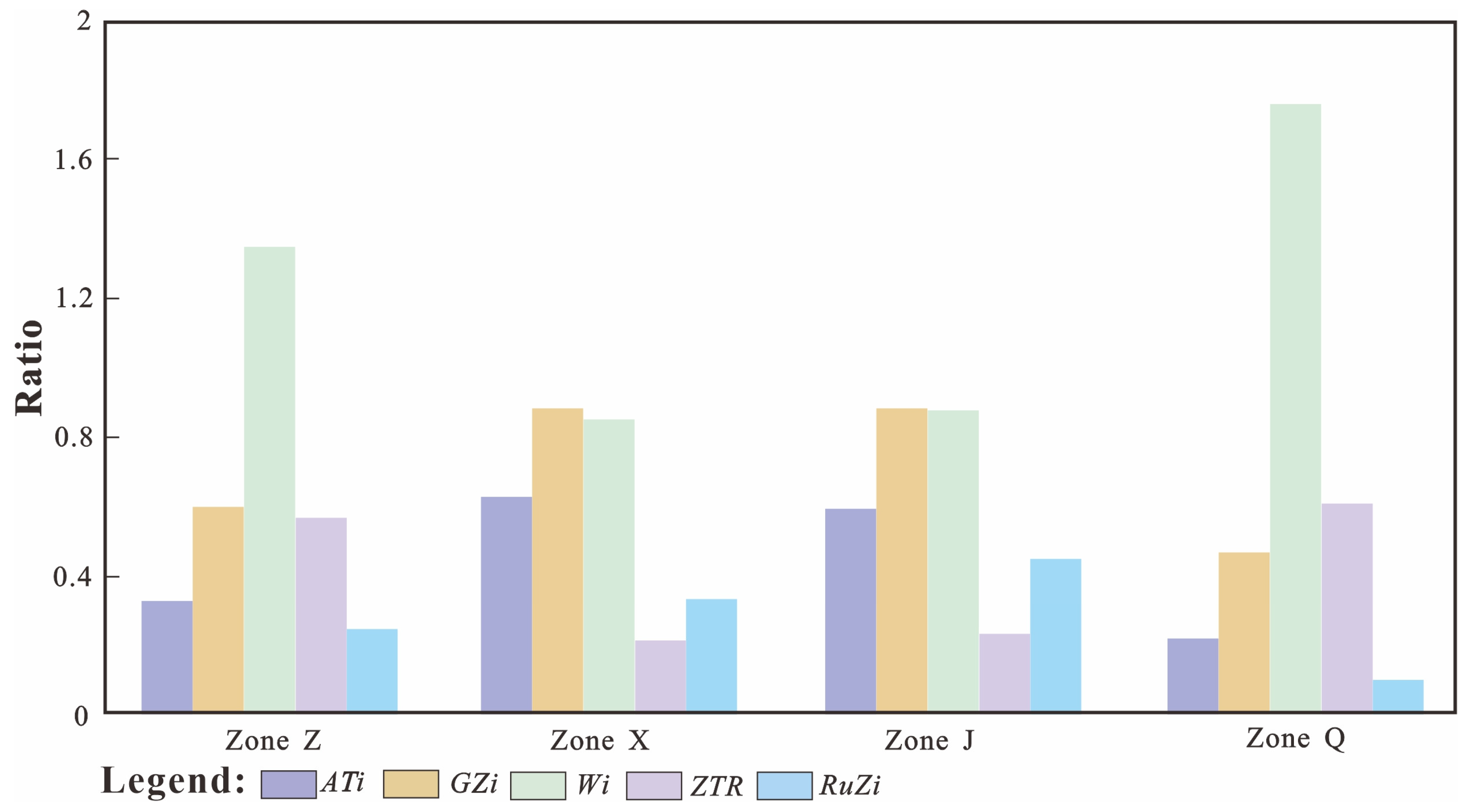



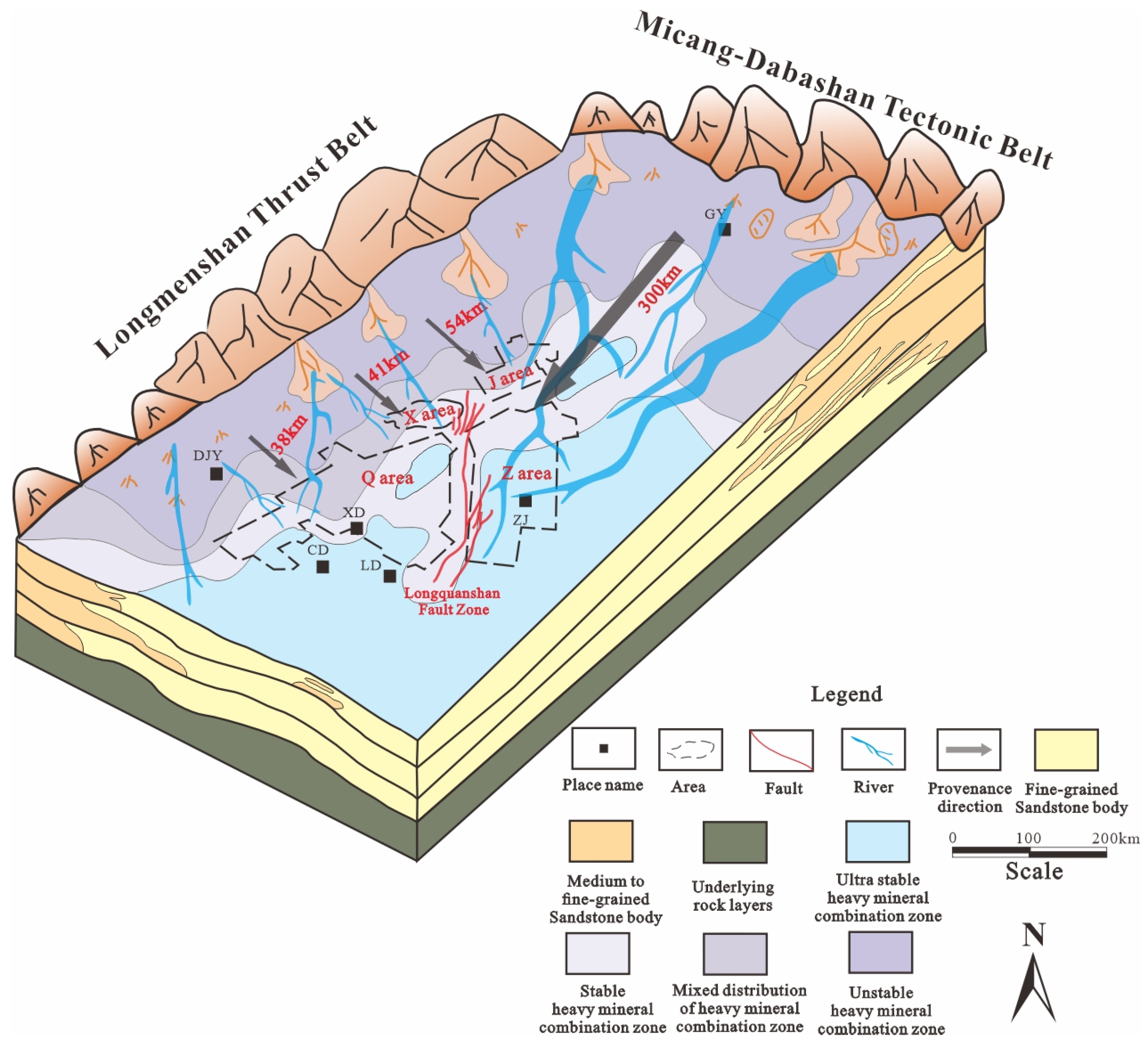
| Zone | Well | Number of Samples | Qm | Qp | Lv | Lsa | Lm | F | L | Lt |
|---|---|---|---|---|---|---|---|---|---|---|
| Zone Z | Z1 | 10 | 34.35 | 5.65 | 7.00 | 10 | 8.00 | 35.00 | 25.0 | 30.65 |
| Z2 | 8 | 35.32 | 2.68 | 8.00 | 10 | 8.00 | 36.00 | 26.0 | 28.68 | |
| Z3 | 12 | 38.38 | 3.16 | 5.26 | 6 | 7.69 | 38.46 | 19.1 | 22.26 | |
| Z4 | 7 | 31.67 | 4.33 | 6.00 | 13 | 10.00 | 35.00 | 29.0 | 33.33 | |
| Z5 | 12 | 36.43 | 4.07 | 14.00 | 11 | 9.00 | 25.50 | 34.0 | 38.07 | |
| Z6 | 13 | 33.55 | 3.45 | 9.76 | 8 | 8.37 | 36.50 | 26.5 | 29.95 | |
| Zone X | X1 | 10 | 61.28 | 1.28 | 1.94 | 13 | 15.39 | 6.83 | 30.6 | 31.89 |
| X2 | 12 | 56.15 | 9.00 | 6.06 | 14 | 9.98 | 4.92 | 29.9 | 38.93 | |
| X3 | 13 | 71.39 | 2.86 | 5.75 | 11 | 7.64 | 1.48 | 24.3 | 27.14 | |
| X4 | 5 | 56.3 | 1.7 | 1.85 | 18 | 10.37 | 11.50 | 30.5 | 32.20 | |
| X5 | 6 | 62.76 | 3.14 | 2.51 | 10 | 8.90 | 12.40 | 21.7 | 24.84 | |
| Zone J | J1 | 13 | 44.39 | 2.21 | 1.79 | 7 | 3.57 | 32.60 | 12.2 | 14.41 |
| J2 | 12 | 54.16 | 1.94 | 1.27 | 9 | 4.65 | 24.00 | 14.8 | 16.74 | |
| J3 | 7 | 43.19 | 1.31 | 1.11 | 7 | 12.50 | 31.40 | 20.5 | 21.81 | |
| J4 | 10 | 47.52 | 1.18 | 1.21 | 9 | 7.50 | 33.50 | 17.8 | 18.98 | |
| J5 | 5 | 45.61 | 0.69 | 1.95 | 6 | 3.27 | 35.20 | 11.4 | 12.09 | |
| J6 | 4 | 46.23 | 0.77 | 1.22 | 6 | 2.94 | 34.50 | 9.9 | 10.67 | |
| Zone Q | Q1 | 6 | 60.33 | 1.33 | 4.45 | 7 | 5.32 | 21.67 | 16.7 | 17.99 |
| Q2 | 10 | 62.64 | 0.76 | 4.40 | 6 | 14.38 | 11.17 | 24.4 | 25.18 | |
| Q3 | 4 | 58.15 | 1.09 | 3.40 | 15 | 12.06 | 10.80 | 29.9 | 31.05 |
| Zone | Well | Garnet | Epidote | Zircon | Apatite | Rutile | Anatase | Tourmaline | Pyroxene | Limonite | Ilmenite | Leucoxene | Iron Pyrite |
|---|---|---|---|---|---|---|---|---|---|---|---|---|---|
| Zone Z | Z1 | 66 | 5 | 7 | 3 | 2 | 1 | 5 | 2 | 3 | 0 | 4 | 2 |
| Z2 | 23 | 14 | 32 | 1 | 11 | 6 | 6 | 0 | 0 | 0 | 5 | 2 | |
| Z3 | 43 | 12 | 14 | 13 | 6 | 1 | 4 | 0 | 1 | 0 | 3 | 3 | |
| Z4 | 37 | 19 | 13 | 11 | 7 | 2 | 5 | 0 | 2 | 0 | 2 | 2 | |
| Z5 | 39 | 21 | 14 | 16 | 3 | 0 | 3 | 0 | 0 | 0 | 2 | 2 | |
| Zone X | X2 | 54 | 0 | 7 | 7 | 3 | 2 | 3 | 0 | 22 | 0 | 2 | 0 |
| X3 | 43 | 0 | 7 | 12 | 3 | 3 | 9 | 0 | 17 | 0 | 6 | 0 | |
| X4 | 68 | 0 | 6 | 6 | 4 | 1 | 6 | 2 | 0 | 0 | 7 | 0 | |
| Zone J | J2 | 51 | 6 | 5 | 7 | 6 | 3 | 5 | 2 | 7 | 0 | 7 | 1 |
| J3 | 57 | 7 | 9 | 6 | 5 | 0 | 4 | 0 | 5 | 1 | 5 | 1 | |
| Zone Q | Q1 | 51 | 5 | 6 | 11 | 4 | 2 | 6 | 2 | 9 | 0 | 4 | 0 |
| Q2 | 52 | 3 | 8 | 8 | 5 | 2 | 8 | 1 | 5 | 2 | 5 | 1 |
| Zone | Well | La | Ce | Pr | Nd | Sm | Eu | Gd | Tb | Dy | Ho | Er | Tm | Yb | Lu |
|---|---|---|---|---|---|---|---|---|---|---|---|---|---|---|---|
| Zone Z | Z1 | 45.5 | 87.1 | 9.9 | 35.7 | 6.1 | 1.2 | 5.8 | 0.81 | 4.44 | 0.98 | 2.74 | 0.32 | 2.60 | 0.40 |
| Z2 | 43.4 | 86.7 | 9.9 | 37.0 | 6.8 | 1.3 | 6.2 | 0.84 | 4.33 | 0.91 | 2.46 | 0.37 | 2.31 | 0.56 | |
| Z3 | 47.4 | 91.5 | 10.4 | 38.4 | 7.4 | 1.4 | 6.9 | 0.99 | 5.11 | 1.09 | 2.86 | 0.34 | 2.74 | 0.42 | |
| Z4 | 45.2 | 95.8 | 11.6 | 32.7 | 6.2 | 1.1 | 6.2 | 0.69 | 4.67 | 1.12 | 2.33 | 0.33 | 2.19 | 0.44 | |
| Z5 | 33.1 | 63.7 | 7.1 | 25.9 | 4.5 | 0.8 | 4.1 | 0.58 | 3.24 | 0.72 | 1.94 | 0.31 | 1.94 | 0.39 | |
| Zone X | X1 | 28.1 | 56.0 | 6.6 | 25.1 | 4.9 | 0.9 | 4.6 | 0.65 | 3.40 | 0.72 | 1.91 | 0.31 | 1.85 | 0.27 |
| X2 | 39.5 | 76.8 | 8.7 | 32.1 | 5.7 | 1.0 | 5.1 | 0.68 | 3.66 | 0.78 | 2.22 | 0.35 | 2.17 | 0.34 | |
| X3 | 55.2 | 104.9 | 11.9 | 42.8 | 7.4 | 1.5 | 6.7 | 0.92 | 5.14 | 1.15 | 3.21 | 0.53 | 3.27 | 0.50 | |
| X4 | 62.6 | 120.2 | 13.9 | 51.6 | 8.7 | 1.5 | 8.0 | 1.02 | 5.70 | 1.27 | 3.68 | 0.60 | 3.94 | 0.62 | |
| Zone J | J2 | 51.2 | 80.5 | 9.6 | 31.7 | 7.4 | 1.2 | 4.2 | 0.67 | 4.29 | 0.99 | 2.55 | 0.36 | 2.08 | 0.54 |
| J3 | 52.4 | 78.5 | 8.9 | 30.3 | 6.9 | 1.2 | 3.8 | 0.62 | 3.78 | 0.78 | 2.35 | 0.29 | 2.17 | 0.39 | |
| Zone Q | Q1-1 | 51.3 | 101.5 | 11.1 | 39.6 | 6.6 | 1.3 | 6.1 | 0.82 | 4.33 | 0.94 | 2.60 | 0.40 | 2.55 | 0.38 |
| Q1-2 | 40.0 | 75.6 | 8.6 | 32.3 | 5.9 | 1.2 | 5.6 | 0.82 | 4.38 | 0.93 | 2.61 | 0.40 | 2.42 | 0.37 | |
| Q2 | 36.3 | 70.0 | 8.1 | 30.0 | 5.7 | 1.2 | 5.4 | 0.79 | 4.15 | 0.88 | 2.37 | 0.37 | 2.32 | 0.35 | |
| Q3 | 40.0 | 76.6 | 8.9 | 32.9 | 5.9 | 1.2 | 5.8 | 0.83 | 4.51 | 0.99 | 2.70 | 0.42 | 2.59 | 0.39 |
| Zone | Well | Sc | V | Cr | Co | Zn | Rb | Sr | Zr | Nb | Ba | Hf | Ta | Pb | Th |
|---|---|---|---|---|---|---|---|---|---|---|---|---|---|---|---|
| Zone Z | Z1 | 12.4 | 155 | 89 | 11.0 | 81 | 172 | 157 | 210 | 10.3 | 760 | 5.56 | 1.00 | 12.1 | 16.0 |
| Z2 | 7.7 | 71 | 56 | 13.1 | 64 | 70 | 294 | 233 | 10.2 | 269 | 6.26 | 0.77 | 12.5 | 11.8 | |
| Z3 | 13.6 | 110 | 91 | 17.9 | 50 | 88 | 170 | 161 | 11.2 | 457 | 4.18 | 0.72 | 7.9 | 16.6 | |
| Z4 | 9.5 | 108 | 86 | 15.2 | 48 | 87 | 146 | 187 | 11.4 | 367 | 4.3 | 0.78 | 8.4 | 14.3 | |
| Z5 | 8.9 | 89 | 77 | 14.1 | 47 | 96 | 83 | 230 | 11.3 | 334 | 5.88 | 0.84 | 7.7 | 12 | |
| Zone X | X1 | 6.2 | 49 | 33 | 10.9 | 45 | 58 | 240 | 124 | 9.4 | 367 | 3.4 | 0.61 | 18.7 | 8.2 |
| X2 | 8.9 | 93 | 72 | 12.4 | 71 | 85 | 151 | 196 | 14.8 | 460 | 5.29 | 0.94 | 9.8 | 12.2 | |
| X3 | 19.5 | 193 | 139 | 21.4 | 83 | 78 | 304 | 181 | 22.5 | 1655 | 4.58 | 0.87 | 8.6 | 16.8 | |
| X4 | 11.4 | 98 | 89 | 14.0 | 88 | 115 | 119 | 433 | 21.5 | 448 | 14.11 | 1.29 | 9.7 | 20.3 | |
| Zone J | J2 | 9.3 | 68 | 74 | 10.2 | 53 | 77 | 149 | 173 | 10.2 | 355 | 4.58 | 0.97 | 8.7 | 13.0 |
| J3 | 12.6 | 101 | 98 | 15.4 | 69 | 62 | 158 | 164 | 10.5 | 299 | 5.47 | 1.33 | 11.2 | 14.7 | |
| Zone Q | Q1-1 | 14.4 | 112 | 103 | 25.0 | 131 | 114 | 268 | 167 | 16.9 | 956 | 4.32 | 1.00 | 26.1 | 15.6 |
| Q1-2 | 9.7 | 91 | 78 | 17.5 | 89 | 88 | 151 | 174 | 15.7 | 573 | 4.59 | 0.97 | 63.3 | 12.1 | |
| Q2 | 9.6 | 92 | 82 | 16 | 82 | 55 | 95 | 170 | 14.4 | 402 | 4.56 | 0.88 | 14.2 | 11.5 | |
| Q3 | 13.5 | 115 | 89 | 14.8 | 95 | 96 | 146 | 136 | 14.8 | 561 | 3.61 | 0.92 | 23.5 | 14.2 |
| Zone | Well | ∑REE | ∑LREE/ ∑HREE | LaN/ YbN | LaN/ SmN | GdN/ YbN | DyN/ SmN | δEu | δCe | La/ Th | La/ Sc | Co/ Th | La/ Yb | Rb/ Sr | Zr/ Hf | Zr/ Th | Sc/ Cr |
|---|---|---|---|---|---|---|---|---|---|---|---|---|---|---|---|---|---|
| Zone Z | Z1 | 203.7 | 10.2 | 11.5 | 4.6 | 1.8 | 0.4 | 0.6 | 0.9 | 2.8 | 3.7 | 0.7 | 17.5 | 1.1 | 37.8 | 13.1 | 0.1 |
| Z2 | 202.8 | 10.4 | 12.4 | 3.9 | 2.1 | 0.4 | 0.6 | 1.0 | 3.7 | 5.6 | 1.1 | 18.8 | 0.2 | 37.2 | 19.7 | 0.1 | |
| Z3 | 216.9 | 9.6 | 11.4 | 3.9 | 2.0 | 0.4 | 0.6 | 0.9 | 2.9 | 3.5 | 1.1 | 17.3 | 0.5 | 38.5 | 9.7 | 0.2 | |
| Z4 | 210.7 | 10.6 | 13.6 | 4.4 | 2.2 | 0.4 | 0.6 | 0.9 | 3.2 | 4.8 | 1.1 | 20.7 | 0.6 | 43.5 | 13.1 | 0.1 | |
| Z5 | 148.1 | 10.3 | 11.2 | 4.5 | 1.7 | 0.4 | 0.6 | 0.9 | 2.8 | 3.7 | 1.2 | 17.1 | 1.2 | 39.1 | 19.2 | 0.1 | |
| Zone X | X1 | 135.3 | 8.9 | 10.0 | 3.5 | 2.0 | 0.4 | 0.6 | 0.9 | 3.4 | 4.5 | 1.3 | 15.2 | 0.2 | 36.5 | 15.1 | 0.2 |
| X2 | 179.2 | 10.7 | 12.0 | 4.2 | 1.9 | 0.4 | 0.6 | 0.9 | 3.2 | 4.4 | 1.0 | 18.2 | 0.6 | 37.1 | 16.1 | 0.1 | |
| X3 | 245.1 | 10.5 | 11.1 | 4.5 | 1.6 | 0.4 | 0.5 | 0.9 | 3.3 | 2.8 | 1.3 | 16.9 | 0.3 | 39.5 | 10.8 | 0.1 | |
| X4 | 283.4 | 10.4 | 10.5 | 4.4 | 1.6 | 0.4 | 0.6 | 0.9 | 3.1 | 5.5 | 0.7 | 15.9 | 1.0 | 30.7 | 21.3 | 0.1 | |
| Zone J | J2 | 197.2 | 11.6 | 16.2 | 4.2 | 1.6 | 0.3 | 0.6 | 0.9 | 3.9 | 5.5 | 0.8 | 24.6 | 0.5 | 37.8 | 13.3 | 0.1 |
| J3 | 192.3 | 12.6 | 15.9 | 4.6 | 1.4 | 0.3 | 0.6 | 0.9 | 3.6 | 4.2 | 1.0 | 24.1 | 0.4 | 30.0 | 11.2 | 0.1 | |
| Zone Q | Q1-1 | 229.5 | 11.7 | 13.3 | 4.8 | 1.9 | 0.4 | 0.6 | 0.9 | 3.3 | 3.6 | 1.6 | 20.1 | 0.6 | 38.7 | 10.7 | 0.1 |
| Q1-2 | 181.2 | 9.3 | 10.9 | 4.1 | 1.9 | 0.4 | 0.6 | 0.9 | 3.3 | 4.1 | 1.4 | 16.5 | 0.6 | 37.9 | 14.4 | 0.1 | |
| Q2 | 167.9 | 9.1 | 10.3 | 3.9 | 1.9 | 0.4 | 0.6 | 0.9 | 3.2 | 3.8 | 1.4 | 15.6 | 1.0 | 37.3 | 14.8 | 0.1 | |
| Q3 | 183.9 | 9.1 | 10.2 | 4.1 | 1.8 | 0.4 | 0.6 | 1.0 | 2.8 | 3.0 | 1.0 | 15.4 | 1.0 | 37.7 | 9.6 | 0.2 |
Disclaimer/Publisher’s Note: The statements, opinions and data contained in all publications are solely those of the individual author(s) and contributor(s) and not of MDPI and/or the editor(s). MDPI and/or the editor(s) disclaim responsibility for any injury to people or property resulting from any ideas, methods, instructions or products referred to in the content. |
© 2025 by the authors. Licensee MDPI, Basel, Switzerland. This article is an open access article distributed under the terms and conditions of the Creative Commons Attribution (CC BY) license (https://creativecommons.org/licenses/by/4.0/).
Share and Cite
Luo, X.; Chen, D.; Feng, S.; Wang, Q. Sedimentary Provenance Analysis of Tight Sandstone Gas Reservoirs in the Middle Jurassic Shaximiao Formation, Western Sichuan Depression. Minerals 2025, 15, 1217. https://doi.org/10.3390/min15111217
Luo X, Chen D, Feng S, Wang Q. Sedimentary Provenance Analysis of Tight Sandstone Gas Reservoirs in the Middle Jurassic Shaximiao Formation, Western Sichuan Depression. Minerals. 2025; 15(11):1217. https://doi.org/10.3390/min15111217
Chicago/Turabian StyleLuo, Xiao, Dongxia Chen, Shaoke Feng, and Qiaochu Wang. 2025. "Sedimentary Provenance Analysis of Tight Sandstone Gas Reservoirs in the Middle Jurassic Shaximiao Formation, Western Sichuan Depression" Minerals 15, no. 11: 1217. https://doi.org/10.3390/min15111217
APA StyleLuo, X., Chen, D., Feng, S., & Wang, Q. (2025). Sedimentary Provenance Analysis of Tight Sandstone Gas Reservoirs in the Middle Jurassic Shaximiao Formation, Western Sichuan Depression. Minerals, 15(11), 1217. https://doi.org/10.3390/min15111217







